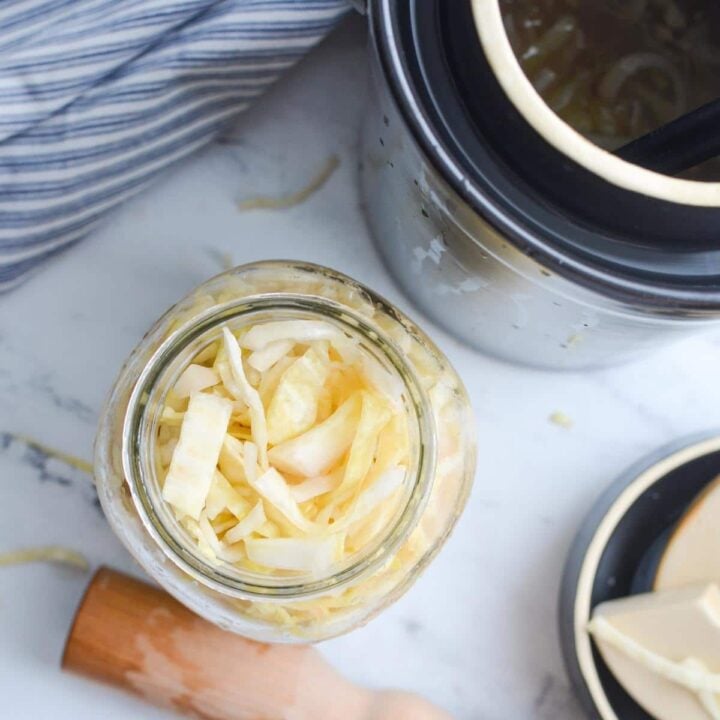Homemade Sauerkraut in a Crock
5.0
(6)
Your folders
Your folders
Prep Time: 1 hours
Total: 1 hours
Servings: 10
Author : Dolly {Little Home in the Making}

Ingredients
Export 2 ingredients for grocery delivery
Instructions
Step 1
Weigh your cabbages to get an exact weight in grams (2kg=2000 grams). Multiply the total weight by 2% to get the minimal salt in grams, and 3% for the upper range of salt in grams. For 2000 grams of cabbage (4.4 lbs) this will equal 40-60 grams but will vary greatly based on the actual weight of your cabbages.
Step 2
Use the upper range of salt if your cabbages are dry or you are a beginner. Use the lower range if you are using a starter culture and are comfortable with fermentation.
Step 3
Remove the outer leaves of your cabbage(s) and cut them in half. Then use a sharp knife to remove the core from the middle and discard it.
Step 4
Slice the cabbage halves into thin slices, anywhere from 1/8 - 1/4" thick. You could also use a food processor or box grater to shred the cabbage, but in my opinion, this style of sauerkraut ferments too quickly and has a less crisp texture.
Step 5
Add the cabbage shreds to a very large bowl (or several bowls) and sprinkle the required amount of salt all over the surface.
Step 6
Use your hands to gently massage the salt into all of the shredded cabbage leaves. Then, use a kraut pounder to begin to "bruise" the cabbage, helping to release some juices.
Step 7
Once the salt has thoroughly been worked into the cabbage, cover it with a lid or damp tea towel and allow it to rest for at least 30 minutes and up to 1 hour. This will give the salt a chance to work and pull any liquid from the shredded purple cabbage.
Step 8
After the cabbage has rested check to see the amount of liquid that was produced - if it was a mere few tablespoons, you're going to need to add water or brine to get an adequate amount of liquid.
Step 9
Add a few handfuls of cabbage to the crock, packing it down tightly after each layer with a kraut pounder. This will also help release additional liquid if there is any remaining in the cabbage.
Step 10
Repeat until all of the cabbage has been packed into the crock (or it reaches about 2" from the top), packing it down as you go. Some brine should rise up to cover the cabbage.
Step 11
If the liquid level is not high enough to submerge the cabbage, either add a small amount of water (if you’re using a 3% salt solution and/or a starter culture), OR prepare a fermentation brine (*See notes).
Step 12
Pour the water or brine into the crock just enough to submerge the shredded cabbage.
Step 13
Once you have enough liquid in the crock, add a fermentation weight on top of the cabbage and press down. This will hold your cabbage under the brine, bringing the liquid level up. If you don’t have a fermentation weight, check the notes** for an alternative.
Step 14
Place the lid on the crock, adding water to the lip if you are using a fermentation crock with a water seal.
Step 15
Place your sauerkraut in a room temperature (around 68ºF or 20ºC) place in your kitchen and ferment for 4-8+ weeks, or until the bubbling and activity have reduced and the sauerkraut tastes and smells pleasantly sour.
Step 16
Once your sauerkraut is fermented to your liking, you're ready to transfer it to storage. Pack it into jars, topping it off with the brine to cover. Place a lid on the jar and transfer it to the fridge or cold storage.
Step 17
Store for several months, or up to a year so long as the quality is good. Signs of spoilage include mold, an off smell, or a slimy texture. Discard if any of it has gone bad and start a new batch.